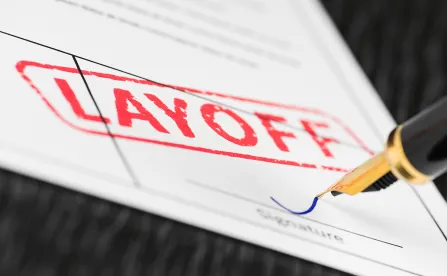The recent, unprecedented changes to our country and its workforce due to the COVID-19 pandemic have upended the lives of millions. The economic fallout continues and in many instances, employers simply have no choice but to lay off large swaths of their employees due to the lack of business/revenue. And these employers have legitimate reasons for doing so and view this as a heart-wrenching but necessary step.
At the same time, a small subset of employers may decide that, even though mass layoffs are not necessary, they will still lay off certain, older employees. In this scenario, there is no legitimate business need driving the termination but an opportunity to let go of older employees who often have higher salaries. Or the employer is concerned that older employees may trigger additional costs in terms of insurance or paid time off because of their susceptibility to COVID-19. Similarly, the employer may hold stereotypical views that older employees are less likely to function well in a virtual/remote work setting that requires technological skills.
As such, the employer’s claim that it had to lay off the older employee due to the pandemic could be a pretext for age discrimination. The question is, how do courts make this call? The answer to this question centers on how an employee can prove that the employer’s purported reasons were just a mask for illegal behavior.
Signs That The Layoff May Be Age Discrimination
Each case will be reviewed based on its own facts and merits, so no “one size fits all” approach can apply when analyzing age discrimination and pretext claims. In the context of COVID-19 layoffs, there are some red flags that may suggest that the employer is targeting an employee(s) because of their age rather than a legitimate business need to reduce the workforce. These red flags include:
-
The company institutes a relatively small-scale layoff, which includes a number of more experienced, older, and higher paid employees
-
Younger, less experienced, and less expensive employees are retained and in some cases take over the work of the departed, older workers
-
Comments by decision-makers reference (or had referenced) the experience level, age, higher salaries, nearness to retirement, etc. of the older employees
-
The employer hires new, younger employees within a relatively short period of time after the older employees are let go
Many companies will be required to provide laid off employees with specific, written information about the employees it chose to lay off, including their job titles and ages. This is helpful information to assess whether age discrimination may have motivated the termination decision. But often it will be necessary to dig deeper into the employer’s data about the laid off employees to see if a correlation between the termination decision and their ages emerges.
Legal Standards For Age Discrimination And Pretext Claims
The key federal law that prohibits age discrimination in employment is aptly named the Age Discrimination in Employment Act (ADEA). It prevents an employer from discharging or otherwise “[discriminating] against any individual… because of such individual’s age.” 29 U.S.C. § 623(a).
To win, a plaintiff “must prove by a preponderance of the evidence that age was the ‘but-for’ cause of the challenged employer decision.” Gross v. FBL Fin. Servs., Inc., 557 U.S. 167, 177-178 (2009). Circumstantial evidence, as opposed to direct evidence of discrimination (which is less frequently available to plaintiffs), is analyzed under a three-part test created by the Supreme Court in McDonnell Douglas Corp. v. Green, 411 U.S. 792 (1973). Note that the Supreme Court clarified that federal employees have a less onerous legal burden to prove in age discrimination claims as compared to private sector employees. Babb v. Wilkie, No. 18-882 (2020).
The McDonnell Douglas framework for an ADEA claim for layoff due to age discrimination is as follows:
STEP 1/prima facie case (burden on plaintiff)
-
They belong to a protected class (older than 40 years old)
-
They were qualified for the job and performing in accordance with the expectations of their employer
-
Employer terminated their employment
-
The employer replaced plaintiff with an individual who was comparably qualified to the plaintiff, but substantially younger, or that they were laid off under circumstances that give rise to an inference of age discrimination
STEP 2 (burden on defendant)
-
Employer must produce evidence that its actions were the result of legitimate and non-discriminatory reasons
STEP 3 (burden on plaintiff)
-
Employee must prove that the non-discriminatory reason(s) offered by the employer in Step 2 were not true reasons, but were a pretext for discrimination based on age.
The Supreme Court held that “it is permissible for the trier of fact to infer the ultimate fact of discrimination from the falsity of the employer’s explanation.” Reeves v. Sanderson Plumbing Prods., 530 U.S. 133, 146-7 (2000). Also, Reeves allows the trier of fact to consider the evidence used to establish a prima facie case of discrimination (first prong of McDonnell Douglas) when they are deciding the final prong of McDonnell Douglas framework. How the employer treats similarly situated (but younger) employees plays a key role in age discrimination cases.
How Can Older Employees Protect Their Rights?
For employees in the private sector, a charge of age discrimination must be filed with the Equal Employment Opportunity Commission (EEOC) within 180 days of the discriminatory act (that is the notice of the layoff). The 180 calendar day filing deadline is extended to 300 calendar days if a state or local agency enforces a state or local law that prohibits employment discrimination on the same basis.
For age discrimination, however, the filing deadline is only extended to 300 days if there is a state law prohibiting age discrimination in employment and a state agency or authority enforcing that law. The deadline is not extended if only a local law prohibits age discrimination.
Note: federal employees have a different charge filing process. Visit www.eeoc.gov for more information.


 />i
/>i

